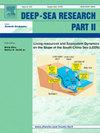评估阿拉伯海东南部浮游有孔虫的生态偏好
IF 3
3区 地球科学
Q2 OCEANOGRAPHY
Deep-sea Research Part Ii-topical Studies in Oceanography
Pub Date : 2025-07-30
DOI:10.1016/j.dsr2.2025.105527
引用次数: 0
摘要
阿拉伯海东南部是阿拉伯海和孟加拉湾水域的汇合处,同时受到夏季和冬季季风的影响。因此,不同的水文参数可能会调节该地区浮游有孔虫的多样性和丰度。因此,我们分析了91个表层沉积物样本,覆盖深度从25米到3150米,以建立特定区域的浮游有孔虫生态学。总体而言,水深、季节叶绿素a和混合层参数对海洋浮游有孔虫丰度有显著影响。共发现有孔虫31种,隶属于17属。我们报告球形球虫是最优势的物种,倾向于高生产力地区。大球虫和橡胶球虫表现出机会性分布模式,而粘球虫、杜特蒂球虫、栽培球虫和糖衣三叶虫表现出区域特异性偏好。gloigerinita glutinata季节性分布有限,而G. hexagonus则普遍存在。从海洋观测中推断出的浮游有孔虫的生态偏好将有助于重建该地区过去的气候条件。本文章由计算机程序翻译,如有差异,请以英文原文为准。
Assessing the ecological preferences of planktic foraminifera from the south-eastern Arabian Sea
The south-eastern Arabian Sea (SEAS) witnesses the confluence of the Arabian Sea and the Bay of Bengal waters along with an influence from both the summer and winter monsoon. As a result, the distinct hydrographic parameters are expected to modulate the diversity and abundance of planktic foraminifera in this region. Hence, 91 surface sediment samples covering a depth range from 25 m to 3150 m were analysed to establish region-specific planktic foraminiferal ecology. Overall, the water depth, seasonal chlorophyll-a and the mixed layer parameters significantly influence the planktic foraminiferal abundance in the SEAS. A total of 31 species of planktic foraminifera belonging to 17 genera were found. We report Globigerina bulloides as the most dominant species, preferring high productivity regions. Globigerina bulloides and Globigerinoides ruber exhibited opportunistic distribution patterns while region-specific preferences were observed for Globigerinita glutinata, N. dutertrei, Globorotalia cultrata and Trilobatus sacculifer. Globigerinita glutinata show a restricted seasonal occurrence while G. hexagonus is reported as a ubiquitous species. The ecological preferences of the planktic foraminifera inferred from the SEAS will help in reconstructing the past climatic conditions from this region.
求助全文
通过发布文献求助,成功后即可免费获取论文全文。
去求助
来源期刊
CiteScore
6.40
自引率
16.70%
发文量
115
审稿时长
3 months
期刊介绍:
Deep-Sea Research Part II: Topical Studies in Oceanography publishes topical issues from the many international and interdisciplinary projects which are undertaken in oceanography. Besides these special issues from projects, the journal publishes collections of papers presented at conferences. The special issues regularly have electronic annexes of non-text material (numerical data, images, images, video, etc.) which are published with the special issues in ScienceDirect. Deep-Sea Research Part II was split off as a separate journal devoted to topical issues in 1993. Its companion journal Deep-Sea Research Part I: Oceanographic Research Papers, publishes the regular research papers in this area.

 求助内容:
求助内容: 应助结果提醒方式:
应助结果提醒方式:


